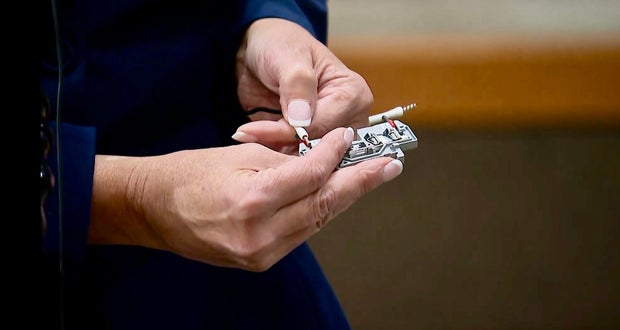A loose wire on the ship Dali may have been responsible for the power outages that eventually led to the collapse of Baltimore’s Francis Scott Key Bridge in 2024, according to the National Transportation Safety Board.
The board heard from several marine and engineering experts during a hearing in Washington, D.C., on Tuesday. They also discussed their final report and voted on the probable cause of the bridge collision and collapse, which killed six construction workers.
The Maryland Transportation Authority said it is reviewing the findings from the final report, and maintained that the bridge collapse was the sole fault of the Dali.
“The collapse of the Francis Scott Key Bridge and the tragic loss of life were the sole fault of the DALI and the gross negligence of its owners and operators,” MDTA said in a statement Tuesday. “The Key Bridge was approved and permitted by the federal government and complied with those permits.”
NTSB
Loose wire discovered on Dali
The National Transportation Safety Board found a misplaced, thick, white label at the end of a small cable pushed it from having a secure connection.
That caused the Dali’s initial power failure and led to a cascading set of problems, ultimately causing the ship to slam into the Key Bridge last year.
Thermal scanners that may have detected that loose connection were not used as part of routine maintenance on Dali’s many wires and cables, the investigation found.
“It just didn’t fit, so it became disconnected. It backed out,” NTSB Chair Jennifer Homendy said. “Sometimes it would hit the face of the spring clamp. There were significant Issues as a result of this, but the work that was done was pretty extensive. I like to say it’s like a needle in a haystack. It is so hard to find, and having our team, which is very meticulous, to find these things, it took a really long time to do that. Finding something that was just slightly displaced is a lot of work.”
CBS News Baltimore
As WJZ Investigates was first to report, Grace Ocean Limited, the Dali’s owner, is suing Hyundai Heavy Industries, alleging they designed a “dangerous” vessel. The lawsuit mentioned that very cable had detached and caused a circuit breaker to open.
“The Dali is almost 1,000 feet, and it’s as long as the Eiffel Tower is high with miles of wiring and thousands of electrical connections,” Homendy said. “Locating a single wire that is loose among thousands of wires is like looking for a loose bolt in the Eiffel Tower.”
NTSB says Key Bridge tragedy was preventable
Homendy stressed in her opening statement that the tragedy was preventable.
“None of us should be here today. This tragedy should have never occurred. Lives should never have been lost. As with all accidents we investigate, this was preventable,” she said.
The NTSB also found that the way mechanical and electrical systems were configured on the Dali cost precious time as the crew scrambled to stop the tragedy, with settings preventing those onboard from quickly restarting emergency generators.
The NTSB also found a lack of redundant safety systems.
The Dali’s flushing pump could not restart automatically when power was restored and required a manual restart that was not able to be done quickly, the investigation found.
The Board did not find fault with the crew.
Warning signs ignored
The hearing into the probable cause of the disaster included a new image of the bridge as it collapsed and of the last vehicle to cross it safely.
NTSB
The NTSB investigation criticized the state for failing to properly warn the six construction workers who lost their lives during the collapse and proposed new regulations to alert workers in the future.
Investigators praised the MDTA officers who stopped traffic and said they “saved lives.”
NTSB
NTSB also found fault with Maryland officials for failing to conduct a vulnerability assessment of the bridge and said the risk of the Key Bridge’s collapse was 30 times higher than what was acceptable, and that the state had been warned.
Investigators said in 2006, an MDTA representative had mentioned pier protection was inadequate, but the state failed to take any meaningful action.
Skyrocketing costs
Maryland officials now say the replacement bridge will cost between $4.3 and $5.2 billion—a sharp rise from the initial estimate of $1.7 to $1.9 billion.
The MDTA pushed back the timeline for completion from late 2028 to late 2030.
“You have costs that are higher than we initially projected. It’s a concern. We just want to work as closely with the federal government as we can to help them understand what we understand now,” said Bruce Gartner, the MdTA’s executive director.
The Trump administration has raised concerns about the escalating costs and construction delays.
In a statement following the NTSB’s hearing, the Maryland Transportation Authority wrote, “The MDTA maintains that the collapse of the Francis Scott Key Bridge and the tragic loss of life were the sole fault of the Dali and the gross negligence of its owners and operators.”
The MDTA continued, “The Key Bridge was approved and permitted by the federal government and complied with those permits. The Key Bridge Rebuild continues to advance in the design process and will have a rigid fender pier protection system to meet today’s American Association of State Highway and Transportation Officials design standards.”




